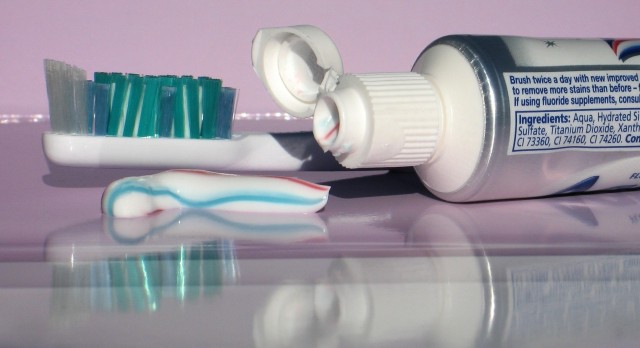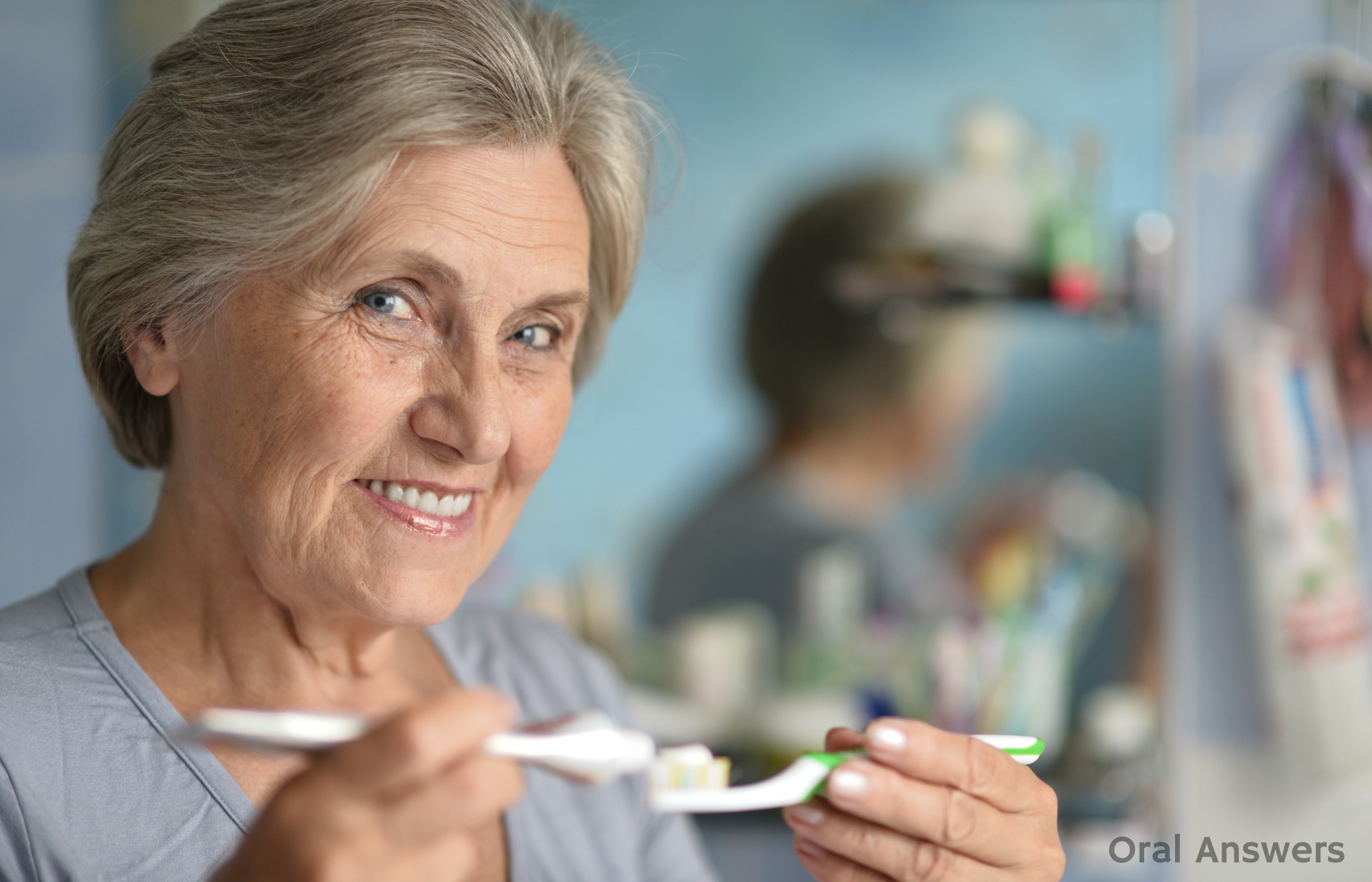Ever since antifreeze chemicals were discovered in toothpaste produced in China several years ago, people have been increasingly concerned about the ingredients found in toothpaste. Luckily, anti-freeze is not found in toothpaste sold in the United States as it is illegal.
Toothpaste consists of several different ingredients that leave our teeth feeling fresh and clean.
So if you’ve ever wanted to know what’s inside that gooey paste that you smear against your teeth everyday, read on.

The Ten Main Ingredients In Your Toothpaste
1 – Fluoride
Fluoride is the only active ingredient found in all toothpastes. It wasn’t until about 50 years ago that fluoride was first added to toothpastes. Fluoride only makes up about 0.15% of most toothpastes, although prescription-strength fluoride toothpastes contain more than 1% of fluoride.
To learn why fluoride is so important, read about the three ways fluoride protects your teeth.
2 – Abrasives
The abrasives found in toothpastes are what help scrape the plaque off of our teeth. I think it’s important to mention that many whitening toothpastes contain too many abrasives, which can wear down the enamel or cementum on your teeth and cause your teeth to be sensitive.
Read this article to learn why whitening toothpaste isn’t making your teeth any whiter.
Some examples of abrasives in toothpastes are mica, calcium carbonate, calcium pyrophosphate, dicalcium phosphate, sodium bicarbonate, and hydrated silica. The mineral mica not only acts as an abrasive, but can add an exciting glitter effect to toothpaste, making the urge to brush almost irresistible!
3 – Detergents
Detergents make people feel like the toothpaste is working by creating bubbles and making the toothpaste foamy. The main detergent in toothpaste is known as sodium lauryl sulfate (SLS.) Some researchers believe that sodium lauryl sulfate causes canker sores, but that’s a topic I’ll discuss in a future article.
4 – Flavors
Flavors are added to most toothpastes. Some common flavors are bubblegum, fruit, mint, and cinnamon. The purpose of the flavors are to mask any unpleasant tastes in the toothpaste and they can also help to freshen your breath by masking the bad odors in your mouth.
5 – Moisturizers and Humectants
A humectant is something that keeps a substance moist. Humectants in toothpaste are what keep the toothpaste nice and smooth and help keep it from drying out. Some commonly-used humectants are glycerin, sorbitol, and water.

6 – Antibacterial Agents
Certain toothpastes contain Triclosan, which is an antibacterial and antifungal agent. It is commonly found in antibacterial soaps. Not too long ago, Colgate started adding it to its toothpaste to create the Colgate Total brand that claims to protect teeth from plaque for up to 12 hours.
7 – Preservatives
Preservatives are added to toothpastes so that microbes don’t grow in the toothpaste and spoil it. It would probably be frustrating if you had to refrigerate your toothpaste — especially if you have teeth that are sensitive to cold temperatures! Thanks to preservatives, toothpaste is safe for many months at room temperature.
8 – Colors
Colors can give toothpaste an attractive appearance. When I was a teenager, I remember my mom had bought some “natural” toothpaste. Being a toothpaste junkie, I decided to try it just for fun to see how it worked. It was a dark brown color and looked pretty gross and tasted even worse. I never used that toothpaste again. A little bit of color could have gone a long way in improving that toothpaste!
9 – Sweeteners
Toothpastes usually contain a substance to make them taste sweet so that we enjoy brushing. Most toothpastes contain saccharin, aspartame, or xylitol to add a bit of sweetness.
10 – Thickeners
In case the toothpaste is too runny, manufacturers can add ingredients that thicken the toothpaste to form a nice, smooth consistency. Carageenan and xanthan gum are common thickeners added to toothpastes.
Bonus Ingredients
Those are the main ingredients in toothpaste. However, some special formulations of toothpaste can include other ingredients such as the ones listed below:
- Peroxides
- Baking Soda (I mentioned sodium bicarbonate above, but some toothpastes go above and beyond and add lots of baking soda to their toothpaste.)
- Anti-tartar (find out what tartar is)
- Anti-sensitivity compounds
Conclusion
Toothpaste requires many ingredients to work the way it does and to have the appearance and taste that it does. The ingredients I have listed are those common to toothpaste sold in the United States, however international brands may vary. If you know of any ingredients I missed or have any questions or comments, I’d love to hear about them below.
Thanks for reading!

Another really interesting and helpful article, Tom! Just curious – are there any concerns with the use of the types of sweeteners you’ve listed, or is the thought that since you rinse it off and no one should swallow toothpaste, it’s all okay?
Thanks for the compliment, Pamela!
I think that the only concern I’ve ever heard of with regards to the sweeteners was about saccharin. In the book Healthy Teeth for Kids, it talks about how saccharin is bad, but the FDA has approved saccharin for human consumption after banning it in the past.
In any case, I don’t think there’s a problem since you end up spitting it out anyways. I haven’t heard of any problems that came from saccharin ingestion due to eating toothpaste.
As for xylitol, that is found in a lot of sugar-free chewing gums and has been shown to improve oral health by fighting against the bacteria in our mouths.
I hope that helps – thanks for your comment!
I never knew all of that was in the toothpaste that I use everyday! You have me on pins and needles wondering about the link between sodium lauryl sulfate (SLS) and canker sores. I hope that article comes out soon!
Hi Benny D – It is interesting that toothpaste has become much more refined than it used to be. Some ingredients used hundreds of years ago were oyster shells, burnt bread, chalk, and powdered brick.
An article about the various “causes” of canker sores will be coming out soon, don’t worry. Thanks for your comment!
What are you thoughts on the use of Triclosan in toothpaste? From everything I’ve read, the addition of Triclosan to so many everyday products is bad news because of bacterial resistance, as well as the fact that there could be potential health risks from having this chemical flowing through our bloodstream on a daily basis. Is Triclosan in toothpaste just a marketing ploy? Would brushing one’s teeth with regular toothpaste after each meal be just as effective?
Hey Rachel – I have also read a lot about Triclosan use in many home care products. Wikipedia does a good job summarizing some of the main concerns with Triclosan.
On the other hand, I do think that triclosan is effective at reducing the number of bacteria on your teeth after you brush. Colgate has stated that there are 70 clinical studies that uphold the safety and effectiveness of Colgate Total. They even state that “these studies showed no findings that would link triclosan in Total to an adverse effect on the endocrine system.”
Overall, I do think that triclosan is good – but too much of it (which we may be getting now) may end up causing resistance problems that we will have to face in the future.
Thanks for your comment, Rachel!
Hi Tom,
I am pretty sure you are aware of home-made “Natural” toothpaste. I would like to know your opinion about it. I have tried baking soda +conut (1:1) for a months or two. I loved the idea to use less chemical, it left me with a clean feel, my gum seemed healthier, but… Can cause sensitivity for cold or hot? Is it harsh or gentle for the enamel in long term use?
Hi Tom
Im an Australian mum with a son with intolerance to sorbitol and xylitol and manitol and every other”ol” that is fed into toothpaste.
I understand why they are there but from my perspective and millions of other IBS sufferes it would be refreshing if the people in the know would market for everyone…not just the unaffected.
Thank you for your insight.
We’re having a debate on flouride and its importance ….could you enlighten us
Kind regards
Jacquelyn.
thank you.
What is the name of any preservative reagent for toothpaste
Triclosan is an FDA listed pesticide …. but it’s ok for kids toothpaste … (not) …. The first rat poison was NaF …. but its also found in some toothpastes … and OK for kids (not) … in little letters … Do Not Swallow … (not) Who was first person to use fluoride … (Hitler) ….
you can get all informative information in our http://www.ggogle.com this link please visit for more updates.
I’m pretty sure you’ve heard of homemade “natural” toothpaste. I’d love to know what you think about it! I’ve been using a mixture of baking soda and coconut oil (1:1) for a couple of months, and I really liked the idea of reducing chemicals. It gave me a clean feeling, and my gums felt healthier too. However, I’m curious—can this cause sensitivity to hot or cold? Is it harsh or gentle on enamel over long-term use? Would love to hear your thoughts! more informationClick here
I’m pretty sure you’ve heard of homemade “natural” toothpaste. I’d love to know what you think about it! I’ve been using a mixture of baking soda and coconut oil (1:1) for a couple of months, and I really liked the idea of reducing chemicals. It gave me a clean feeling, and my gums felt healthier too. However, I’m curious—can this cause sensitivity to hot or cold? Is it harsh or gentle on enamel over long-term use? Would love to hear your thoughts! more information